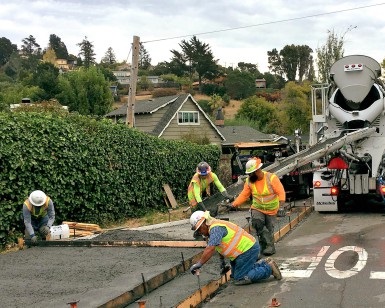San Rafael, CA – For over a decade, the County of Marin has been among the municipal pacesetters in the adoption of sustainable, or green, building standards. Even before most jurisdictions had Climate Action Plans, the Marin County Community Development Agency (CDA) set goals of reducing greenhouse gas emissions during the building process. One Marin Countywide Plan program focuses on the need for regulation of the use of concrete, the most widely used construction material in the world and the source of up to 10% of human-created carbon dioxide emissions.
 The County of Marin is encouraging the use of concrete-making materials that cost about the same as cement but are more environmentally friendly.
The County of Marin is encouraging the use of concrete-making materials that cost about the same as cement but are more environmentally friendly.
A big step toward implementing the program was taken November 19 when the Marin County Board of Supervisors
followed CDA’s recommendation and approved the addition of language in the Marin County Code that minimizes the use of cement, the powdery glue that holds concrete together.
The new County Code subchapter will encourage the use of supplementary cementitious materials (SCMs) that cost about the same as cement and are considered equally effective at making sturdy concrete but with lower emissions.
The County’s green building policies are designed to promote sustainability and innovation in building materials while also being responsive to local conditions, such as SCM availability in Marin and the Bay Area. CDA staff said the new standards were developed with substantial review and feedback by technical consultants and a regional stakeholder group, convened with the assistance of a grant from the Bay Area Air Quality Management District. The group, which worked on the codes as part of the Bay Area Low-Carbon Concrete Codes Project, included representatives from cities, counties, universities, engineers, architects, the concrete industry, and the U.S. Green Building Council.
“This is an important step toward addressing emissions from building activity in a more holistic way and with global climate impacts in mind,” said CDA Deputy Direct Bill Kelley. “Through this new policy, we stay on the path toward construction techniques that minimize harm to the environment, limit contributions to climate change, and support best practices.”
The ordinance will apply to permitted building activities and public projects developed by the County of Marin. As with all the County’s green building policies, there are exemptions for circumstances in which applicants cannot comply because of disproportionate financial impact to the project or lack of commercially available materials. Allowances are also built into the County Code language for projects that require quicker curing times for concrete.
Kelley said the low-emission concrete ordinance was designed to serve as model code language for other local governments, as outlined in the grant from the Bay Area Air Quality Management District.
Learn more about the County’s green building program and Climate Action Plan online.